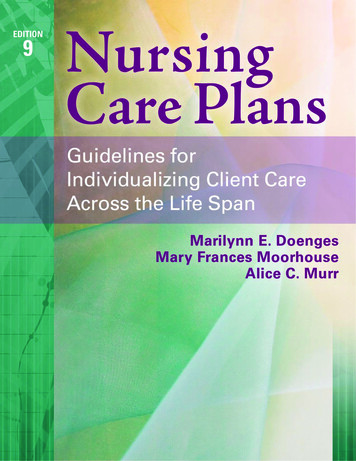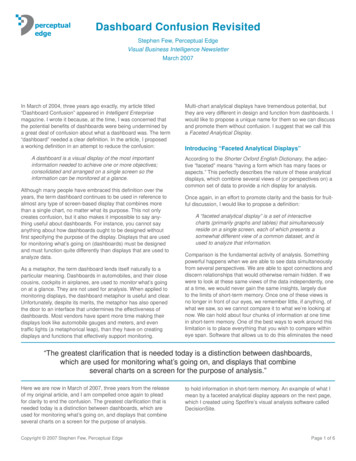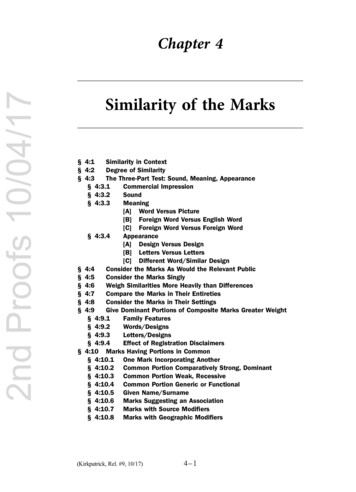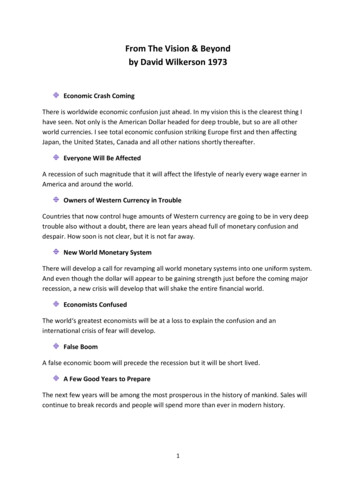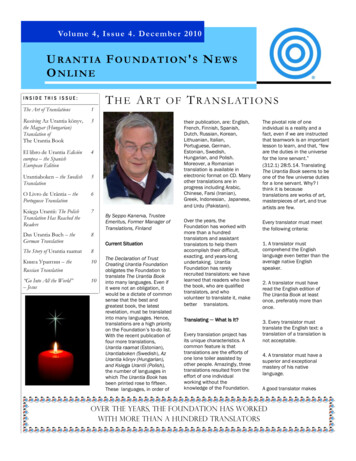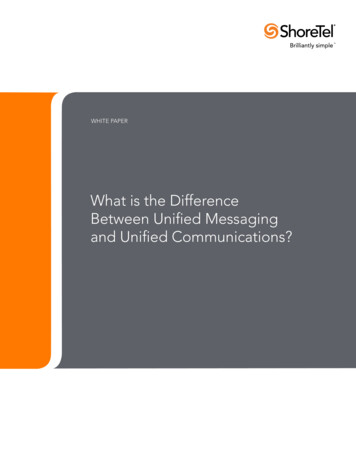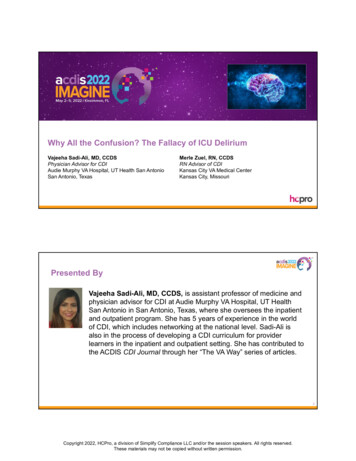
Transcription
Why All the Confusion? The Fallacy of ICU DeliriumVajeeha Sadi-Ali, MD, CCDSPhysician Advisor for CDIAudie Murphy VA Hospital, UT Health San AntonioSan Antonio, TexasMerle Zuel, RN, CCDSRN Advisor of CDIKansas City VA Medical CenterKansas City, Missouri1Presented ByVajeeha Sadi-Ali, MD, CCDS, is assistant professor of medicine andphysician advisor for CDI at Audie Murphy VA Hospital, UT HealthSan Antonio in San Antonio, Texas, where she oversees the inpatientand outpatient program. She has 5 years of experience in the worldof CDI, which includes networking at the national level. Sadi-Ali isalso in the process of developing a CDI curriculum for providerlearners in the inpatient and outpatient setting. She has contributed tothe ACDIS CDI Journal through her “The VA Way” series of articles.2Copyright 2022, HCPro, a division of Simplify Compliance LLC and/or the session speakers. All rights reserved.These materials may not be copied without written permission.
Presented ByMerle Zuel, RN, CCDS, RN advisor of CDI at Kansas City VA MedicalCenter in Kansas City, Missouri, has been involved in national CDIimprovement efforts. Nationwide networking through the VA and otherorganizations has shaped his knowledge of the challenges faced byprivate-sector employees entering the VA system in CDI. A member ofthe ACDIS Leadership Council, Zuel has contributed to the ACDISCDI Journal through his “The VA Way” series of articles.3So why all theconfusion?What are some of the challenges youas CDI professionals face when yousee " AMS " in the chart Open forum4Copyright 2022, HCPro, a division of Simplify Compliance LLC and/or the session speakers. All rights reserved.These materials may not be copied without written permission.
Learning Objectives At the completion of this educational activity, the learner will be able to:#1Discuss thedifferent types ofencephalopathywith caseexamples anddiscussion#2Differentiatedelirium fromencephalopathy anddiscuss caseexamples#3Identify effectiveand creativeways for providereducation andcollaboration56Copyright 2022, HCPro, a division of Simplify Compliance LLC and/or the session speakers. All rights reserved.These materials may not be copied without written permission.
Let’s startwith a littlechallengeCase #169 yo male presents to the ED via EMS and now admitted toICU due to combativeness, patient swinging his fists atnursing providers. Hemodynamically stable butseverely confused, incoherent. All labs unremarkable exceptliver enzymes mildly elevated. Neuro consult indicatesschizophrenia with hx of seizures and hx of neurolepticinduced dyskinesia. Holding PTA quetiapine 400mg daily,venlafaxine 150mg daily, pregabalin 300mg BID andmodafinil 200mg daily due to NPO status. Intermittentlydirectable, continued lethargy, rhythmic movements of handsand mouth. Haldol 5mg given in ED for severe agitation.Psych consult pending.Provider Assessment and Plan:Metabolic vs Toxic encephalopathy, Schizophrenia.-Encephalopathy 2/2 subclinical seizure vs ICU delirium vsMedication induced vs SepsisPoll Question 1 Which conditions would you be able to code from thescenario?–––––Metabolic encephalopathyToxic encephalopathySchizophreniaSeizure disorderAdverse effect of neuroleptics8Copyright 2022, HCPro, a division of Simplify Compliance LLC and/or the session speakers. All rights reserved.These materials may not be copied without written permission.
POLLING RESULTSQuestion 19Case #1 Discussion10Copyright 2022, HCPro, a division of Simplify Compliance LLC and/or the session speakers. All rights reserved.These materials may not be copied without written permission.
Case #288-year-old woman admitted for fever, and confusion, unable toobtain history from patient. Granddaughter at bedside. Statespatient has been having fever for the last 2-3 days and a cough,they haven’t measured the temp at home. She doesn’t reallyseem to think patient is more confused, but states that thepatient isn’t conversing much since she got sick, she has beenchoking on her food a lot. Labs significant for WBC 18K,otherwise rest of CBC normal. Cr of 3.0, lactic acid normal, restof CHEM normal. CXR significant for right middle lobe opacity,CT head with chronic microvascular changes.UA neg, urine andblood cultures pendingPhysical ExamVitals : 87/56, HR 120, RR 20 T 39General : Appears stated age, NADHEENT : PERRLA, EOMI , dry mucus membranesCVS : RRR, no murmursResp : Right Lung RhonchiAbdomen : Soft , NT, NDNeuro : Alert , oriented x 1,confused.Case #2ContinuedAssessment and Plan:SepsisAcute kidney injuryPneumoniaAcute deliriumStart ceftriaxone and azithromycin Repeat labs Cultures pendingHTN – continue home medsDM – lantus 10 U and sliding scaleCopyright 2022, HCPro, a division of Simplify Compliance LLC and/or the session speakers. All rights reserved.These materials may not be copied without written permission.
Poll Question 2 Would you query for the patients baseline mental status?– Yes– No13POLLING RESULTSQuestion 214Copyright 2022, HCPro, a division of Simplify Compliance LLC and/or the session speakers. All rights reserved.These materials may not be copied without written permission.
Case #2 Discussion15“Altered Mental Status”Hmm, that’s very interesting.Please tell me more Altered mental status is a non-specific diagnosis (symptom )offering minimal impact to severity of illness or risk of mortality.How is the mental status altered?Coma? Manic Episode? Depression?Hallucinations?What is the suspected underlyingphysiological cause?16Copyright 2022, HCPro, a division of Simplify Compliance LLC and/or the session speakers. All rights reserved.These materials may not be copied without written permission.
Acute Encephalopathy Basic definition – diffuse disease of the brain that alters brain function orstructure – widespread. Evidence may show up on EEG but not required to make the diagnosis Lasts up to 2-3 days, can last weeks (uncommon) Clinical indictors often point to a specific type, typically metabolic. Overlapping criteria with the psychiatric diagnosis of delirium. Correction of the underlying cause will reverse encephalopathy Not due to structural abnormalities of the brain. May be superimposed on baseline cognitive disorders or chronicencephalopathies.17Acute Encephalopathy Types Metabolic-MCC - most frequent type seen. Related to metabolic abnormalities,infections, impaired oxygenation, impaired clearance of waste. SepticEncephalopathy is Metabolic Encephalopathy Toxic-MCC - caused by a specific drug or toxin and typically improves as theinsult is removed or metabolized. Providers must indicate the specific drug ortoxin now to code. (Effective Oct 1, 2021) Hepatic-MCC - synonymous with hepatic failure but not coma. Documentationshould indicate with/without coma and other associated clinical indicators ofacutely impaired liver function. (transaminitis, increased ammonia level, coagulopathy) Unspecified CC - documentation should always seek to specify the type ofencephalopathy to avoid degrading the severity of illness of the case.18Copyright 2022, HCPro, a division of Simplify Compliance LLC and/or the session speakers. All rights reserved.These materials may not be copied without written permission.
“Other” Encephalopathy Other Encephalopathy - used when encephalopathy is reported due to acondition (e.g., due to urinary tract infection or secondary to a lacunar infarct)without specification of a type of acute encephalopathy. Anoxic/Hypoxic - chronic permanent brain damage related to a prolongedperiod of hypoxia. Rapid onset, unlike other chronic encephalopathy butirreversible. Do not confuse with metabolic encephalopathy due to hypoxiawhich is reversible when respiratory support is initiated and resolves as thesystemic insult improves. Wernicke/Korsakoff Syndrome - chronic encephalopathy typically seen inalcohol dependence related to thiamine deficiency, overall poor nutritionalstatus. All chronic encephalopathy should be documented when present withthe cause and specific type indicated.19Dementia and Encephalopathy DSM-V Major Neurocognitive Disorder with/without behavioraldisturbance (Dementia) – Chronic progressive decline in cognition andexecutive function. The baseline level of functioning is stable unless somethingcauses a change from the baseline. Documentation should always indicate ifwith or without behavioral disturbance. Encephalopathy Superimposed on Dementia – Documentation shouldclearly delineate a deviation from baseline cognitive functioning. Supportingindicators should be present including presence of metabolic abnormalities orinfections. The best evidence to support the diagnosis is a documented returnto baseline cognitive functioning after the insult is treated or removed. Both arevalid diagnoses and should be reported when present.20Copyright 2022, HCPro, a division of Simplify Compliance LLC and/or the session speakers. All rights reserved.These materials may not be copied without written permission.
Case #378 y/o patient admitted with chief complaint ofaltered mental status and found to have a urinarytract infection.Per EMS his sister reports he was started onLevaquin by his outpatient provider 2 days agoand with no apparent improvement.Unclear if he has been taking the medication asprescribed.Unable to obtain history or review of systems dueto AMS.Patient now agitated and requiring soft restraints,pulling at lines admitted to ICU for stabilization.Poll Question 3 What would your anticipated query be for?–––––No query neededMetabolic encephalopathyDeliriumToxic encephalopathyOther Unspecified encephalopathy22Copyright 2022, HCPro, a division of Simplify Compliance LLC and/or the session speakers. All rights reserved.These materials may not be copied without written permission.
POLLING RESULTSQuestion 323Coding Clinic Guidance When encephalopathy is attributed to another medical condition such as strokeor UTI it is appropriate to use the code “other encephalopathy” if a specifictype of encephalopathy is not documented. Seizures- Post ictal state is inherent to seizures – do not seek out metabolicencephalopathy Hepatic encephalopathy is not synonymous with hepatic coma. Code G93.41 metabolic encephalopathy for sepsis associated encephalopathy Documentation of delirium not otherwise specified (NOS) is assigned R41.0,Disorientation, unspecified. F05, Delirium due to known physiological condition, provides a CC as asecondary diagnosis. The Excludes1 note lists delirium NOS (R41.0). A note forF05 instructs to “code first” the underlying physiological condition.24Copyright 2022, HCPro, a division of Simplify Compliance LLC and/or the session speakers. All rights reserved.These materials may not be copied without written permission.
“ICU Delirium”Okay now that’s justcrazy talkAltered mental status is a non-specific diagnosis (symptom )offering minimal impact to severity of illness or risk of mortality.The physical location of the patient is nota modifier of this psychiatric diagnosis“He had a GI lab myocardial infarction”“She has cafeteria appendicitis”See how funny that sounds when applied to other diagnoses?25ACUTE ENCEPHALOPATHY IS ANEUROLOGICAL DIAGNOSISDELIRIUM IS A DSM-V PSYCHIATRICDIAGNOSISIt is defined as any diffuse disease ofthe brain that alters brain function orstructure. The hallmark ofencephalopathy is an altered mentalstate. common neurological symptomsare progressive loss of memory andcognitive ability, subtle personalitychanges, inability to concentrateDefined by the DSM-V as adisturbance in attention andawareness, reduced orientation to theenvironment. Patients will demonstratean additional disturbance in cognitionrelated to memory, disorientation,language, and perception.Which do you think the ICD-10 weighs more heavily?26Copyright 2022, HCPro, a division of Simplify Compliance LLC and/or the session speakers. All rights reserved.These materials may not be copied without written permission.
Delirium vs. Acute Encephalopathy Delirium and acute encephalopathy are essentially 2 different terms describingthe same constellation of symptoms. The clinical indicators overlap. Delirium identifies the behavioral manifestation. Encephalopathy identifies the underlying pathophysiologic process responsiblefor the behavioral alteration. Treatment is generally to remove or negate the impacts of the systemic factorsresponsible–(infection, fluid & electrolyte imbalances, hypoxia,, drugs, toxins) Delirium Tremens is a valid diagnosis when the alteration in mental status isrelated specifically to alcohol withdrawal. Many providers are not aware that the diagnosis of delirium dilutes the severityof illness of their patient compared to documenting a specified type ofencephalopathy27Delirium: A Psychiatric Diagnosis According to the American Journal of Psychiatry, delirium is a syndrome ofacute brain failure that is the direct pathophysiologic consequence of anunderlying medical condition or toxic exposure. Although delirium is common, the diagnosis relies on a high index of suspicion,as it often goes undetected or misdiagnosed. A thorough clinical evaluation isconsidered the gold standard for diagnosis of delirium, as there is no clinicalstudy or biomarker with high sensitivity and specificity. ICU Delirium Delirium NOS R41.0 – a symptom code, no impact Overlapping diagnostic criteria with neurological diagnosis of encephalopathy. ICD-10 assigns less severity of illness to the psychiatric diagnosis.28Copyright 2022, HCPro, a division of Simplify Compliance LLC and/or the session speakers. All rights reserved.These materials may not be copied without written permission.
Case #467 y/o patient admitted with chief complaint ofshortness of breath, confusion with a history ofalcohol use disorder in remission found to beCOVID . Patient reports history of COPD andcompliance with medications. Current dailysmoker, no other drug use reported. Transferred toICU overnight due to increased oxygen demandsand worsening hypoxia, agitation, and confusion.Dx: Acute hypoxic respiratory failure 2/2 COVID19 pneumonia, ICU delirium, COPD, tobacco usePoll Question 4 What query opportunity would you pursue?–––––No query neededQuery for metabolic encephalopathyQuery for delirium tremensQuery for toxic encephalopathyQuery for alcohol withdrawal30Copyright 2022, HCPro, a division of Simplify Compliance LLC and/or the session speakers. All rights reserved.These materials may not be copied without written permission.
POLLING RESULTSQuestion 431Clinical Judgement Is the Key There is nothing more valuable than consistent documentation that a conditionexists. This is especially true for the diagnoses of acute encephalopathy anddelirium. Delirium is assigned less weight in ICD-10 than acute specifiedencephalopathy. Neither diagnosis can be definitively proven or disproven dueto the overlapping diagnostic criteria. so the clinical opinion of the attendingprovider carries more weight. Do not let Recovery Auditors bully or derail your efforts to improve your severityof illness by targeting acute encephalopathy for denial when it is the lone MCC.Educate providers about the need for clear, congruent and consistentdocumentation will help prevent some of those challenges.32Copyright 2022, HCPro, a division of Simplify Compliance LLC and/or the session speakers. All rights reserved.These materials may not be copied without written permission.
Case #572 y/o patient admitted via EMS from home withchief complaint of pain. PMH of DMII, HTN,COPD, recent hospitalization for diabetic foot ulcerdebridement. Patient only oriented to person andunable to give meaningful history. Wife reported toEMS that patient is normally very active andA&Ox4 Malodorous foot wound appears to beinfected with possible osteo. Vascular and Orthoconsults ordered. CT of head no acuteabnormalities. Vanc/Zosyn started in the EDDx: Sepsis 2/2 to non-healing diabetic footwound., altered mental status versus ICU deliriumPoll Question 5 How would you clarify the differential diagnosis?–––––No query neededQuery for metabolic encephalopathyQuery for deliriumQuery for toxic encephalopathyQuery for septic encephalopathy34Copyright 2022, HCPro, a division of Simplify Compliance LLC and/or the session speakers. All rights reserved.These materials may not be copied without written permission.
POLLING RESULTSQuestion 535Provider Engagement Tips Teaching physicians. Physician advisor/champion RN Advisor specific to CDI to engage and educate providers on ICD-10documentation requirements. Query choices – clinical indicators must be clear and specific. 1:1 education 15 mins Tip cards Lunch and learn Ongoing education, outreach and collaboration with providers.36Copyright 2022, HCPro, a division of Simplify Compliance LLC and/or the session speakers. All rights reserved.These materials may not be copied without written permission.
Thank you. In order to receive your continuing education certificate(s) for this program, you must complete the onlineevaluation. The link can be found in the continuing education section of the program guide.37Copyright 2022, HCPro, a division of Simplify Compliance LLC and/or the session speakers. All rights reserved.These materials may not be copied without written permission.
Metabolic-MCC - most frequent type seen. Related to metabolic abnormalities, infections, impaired oxygenation, impaired clearance of waste. Septic Encephalopathy is Metabolic Encephalopathy Toxic-MCC - caused by a specific drug or toxin and typically improves as the insult is removed or metabolized. Providers must indicate the specific .



